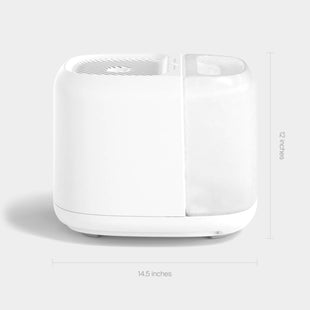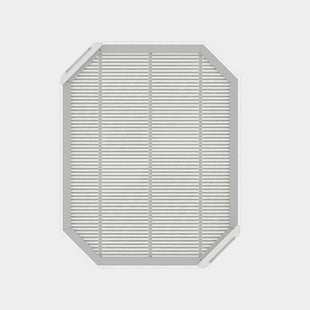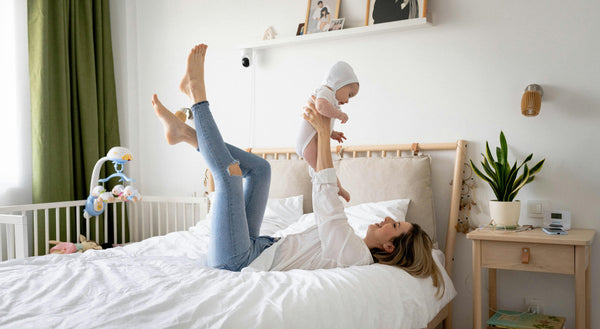This content has been reviewed and updated on January 10, 2024
When assembling a nursery for a new baby, you’ll find a wide range of gadgets and devices to keep them as healthy as possible. From bottle warmers and sterilizers to wipe warmers, you might wonder how many items a baby actually needs.
While you may not need everything that baby books list as “must-haves,” one device you should definitely consider using wherever your little one sleeps is a humidifier. A high-quality humidifier can keep an infant comfortable and healthy, including alleviating congestion, repairing dry skin, and reducing airborne bacteria that can cause illness.
To ensure you get the most out of a humidifier in the nursery and avoid some of the pitfalls that can create health risks or dangers, we’ve compiled this guide on everything you need to know about where to place it and how to use it properly.
The Canopy Guide on How to Use a Humidifier for Your Baby

The most common question new parents ask about using a humidifier in a nursery is, “How close should a humidifier be to the baby?” The short answer is to place it about 3 feet from the crib. This distance prevents excessive exposure to the moisture emitted by the humidifier, which can dampen bedding, pillows, or stuffed animals and support mold and bacteria growth.
The recommended distance from the crib is just one factor to consider when deciding where to put a humidifier in the nursery. You must also consider child safety and the device’s effectiveness when selecting a location.
Airflow
Choose a central location within the nursery to ensure moisture flows throughout the room. Putting it in a corner could cause the moisture to concentrate in one spot, limiting its benefit to only that area.
Proximity to the Sleeping Area
Place the humidifier about three to four feet away from the crib. This distance ensures that the mist doesn’t saturate bedding, curtains, or any other fabric, as well as ensures that the air surrounding the baby isn’t too humid.
Safety
Even if you use a cool mist humidifier, avoid placing it where the cord can become a tripping hazard or where it could fall into the crib or on the baby. Even babies who aren’t yet standing or walking can accidentally pull a humidifier onto themselves if the cord is within reach, so make sure it’s on a stable surface well out of reach.
Mist Style
Pediatricians typically recommend cool mist humidifiers for nurseries, as they do not create a burn hazard like a warm mist humidifier or vaporizer, which boils water to create steam. An even safer option is a clean moisture humidifier with evaporative mist technology, like the Canopy Nursery Humidifier, which is made for babies' rooms.
Canopy's room-size humidifiers don’t produce any mist but rather produce clean, hydrated air. The disposable paper filter eliminates contaminants from the water, and Smart Persistent Airflow™ technology helps prevent mold. You can enjoy the benefits of a humidifier without the risk of water damage, wet bedding, mold, or bacteria.
Does My Baby Need a Humidifier?
Many adults associate humidifiers, especially warm mist vaporizers, with being sick. It’s common to add steam to the room when you have a cold or the flu to help break up mucus and reduce congestion.
That’s why many parents wonder whether they need to invest in a humidifier for the nursery when their baby isn’t sick. Most infants and toddlers benefit from one, especially during the winter when the air tends to be drier and germs run rampant. Increasing indoor humidity with clean hydration can help with many common ailments in babies, like nasal congestion and dry skin.
Using a Humidifier for Nasal Congestion
Newborns often experience nasal congestion due to the new environment outside the womb. It takes time to adjust to dry air, allergens, pets, and new smells and clear out any fluid that might have gotten into their sinuses during or after birth. This nasal congestion can cause your baby to have the sniffles and make extra noise while they sleep.
A humidifier can help lubricate your baby’s nasal passage and prevent the blockages that lead to uncomfortable congestion. Moisture also helps quell inflammation which can slow down mucus production and keep your child breathing easy.

Using a Humidifier for Dry Skin or Eczema
Your baby’s skin is ultra-sensitive and prone to dryness, redness, and irritation from exposure to everything from the air to harsh soaps and laundry detergent. More than 10% of children under age 5 have atopic dermatitis or eczema, a type of dry skin that can crack, itch, and look red and inflamed.
When your baby’s sensitive skin is dry and irritated, a humidifier can help provide relief and keep the symptoms from worsening. Adding extra moisture to the air helps maintain the skin’s moisture barrier, keeping your baby’s skin soft and itchy rash-free, without the need for special soaps, lotions, or medication.
Using a Humidifier to Reduce the Chances of Getting Sick
Everyone gets sick, and children are especially at risk for common colds, flu, and other ailments because they don’t have mature immune systems yet. Keeping your new baby at home and away from germs as much as possible during cold and flu season is a smart decision, but it’s impossible to keep every virus away. Using a humidifier in the nursery can help when you want to reduce the risk of your child coming in contact with airborne viruses and bacteria.
A 2020 study by the Annual Review of Virology revealed that elevated humidity can reduce the survival rate of airborne pathogens, improve the body’s immune response, and help the body ward off foreign invaders. Investing in a humidifier for the nursery can not only reduce your baby’s risk of exposure to viruses and bacteria, but it can also help them develop a strong and healthy immune system.
Using a Humidifier for Sleep
Adding a humidifier to your baby’s nursery can help them sleep. In addition to relieving congestion and sinus dryness, a Canopy Nursery Humidifier creates gentle and soothing white noise and includes an optional aromatherapy feature. Canopy created two scents specifically for little ones: Rise, a sweet orange and eucalyptus blend to help with breathing and Lull, a calming vanilla and lavender aroma that helps them drift off to sleep.
Canopy Humidifier for Baby
The Little Dreams humidifier bundle was designed for use in the nursery to give babies clean, healthy, hydrated air that helps them sleep better, alleviates nasal congestion, and supports healthier skin and breathing. The included aroma oils create a fresh, comfortable environment that is stimulating during the day and soothing at night.
You never need to worry about hot water splashing out or excessively damp or moldy surfaces, thanks to Canopy’s evaporative mist technology. The no-mess humidifier uses built-in sensors to maintain optimal humidity levels day and night, so you can worry about other things.
All Canopy humidifiers produce clean moisture thanks to UV-light technology that kills 99.9% of bacteria in the water and a disposable paper filter that catches any remaining contaminants. You don’t have to worry about a dirty water tank or mold buildup in the humidifier either, thanks to incredibly low-maintenance, dishwasher-safe components and filter and scent subscriptions that replenish your supply every six weeks.
Canopy makes it easy to help your baby stay healthy and comfortable with the Little Dream humidifier bundle. Or, invest in a Humidifier Plus large-format humidifier and enhance your entire home with clean hydration and soothing aromatherapy. Explore and shop our bundles and accessories today to find the perfect baby shower gift or a present for yourself.































